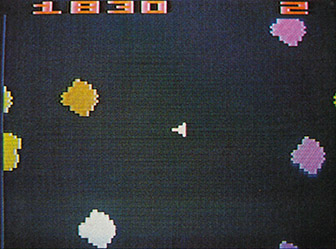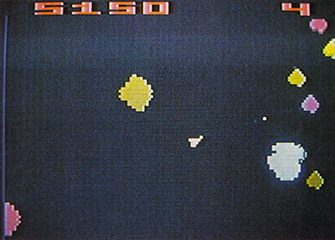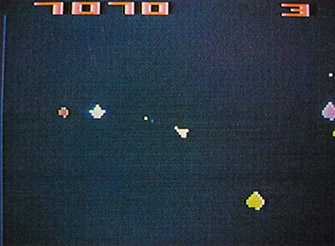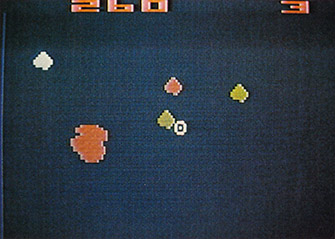
Asteroids
Ordinarily, when you get a bunch of rocks thrown at you, it’s not a whole lot of fun. But when it’s your TV set that’s doing the throwing during a game of Atari’s Asteroids, well, that’s another story.
In Asteroids, you pilot a spaceship that’s free-floating through the middle of a never-ending Asteroid belt. To make matters worse, while you blast and/or dodge your way through the space debris, your ship is attacked by merciless Satellites and UFOs.
Asteroids is one of those “must have” Atari cartridges. First off, it’s a great deal of fun to play. Secondly, it’s a game your non-Atari-owning friends will want to play when they visit. Finally, you need one — if nothing else — for the practice. It’s a strong possibility that your Atari-owning friends also own Asteroids cartridges — you don’t want to look bad when you visit them and get creamed playing the game, do you?
Asteroids is a fun game to play. And when was the last time you could say you had fun while getting rocks thrown at you?
Atari, Inc.
for Atari VCS
$37.95/$27.00-30.00
1 to 2 players
Rating: PG
Graphics: 7
Game Play: 8
Longevity: 7
OBJECTIVES
To destroy Asteroids, Satellites, and UFOs for points and keep your Spaceship alive for as long as possible.
CONTROLLERS
Asteroids is played using the Atari joystick controller. The game should be played using a light touch on the joystick at all times. Before you can score high at Asteroids, you must practice all of the joystick’s functions thoroughly.
Moving the joystick to the right rotates the Spaceship clockwise; moving the joystick to the left rotates it counterclockwise. The slightest push forward on the joystick will thrust the Spaceship in the direction it is pointed. Too heavy a hand will thrust the Spaceship out of control. To stop or slow down a drifting Spaceship, point the ship in the opposite direction of its movement and hit the thrust control.
ELEMENTS
Spaceship: This is you, free-floating through wave-after-wave of Asteroids. You can move anywhere on the screen, using your thrust controls. If you move off one side of the screen, you will “wraparound” and reappear on the other side (top/bottom or left/right). Though you have total freedom of movement, you are almost always better off staying at the center of the screen — where you begin — and firing at the Asteroids drifting around you. This eliminates the possibility of accidentally running into an Asteroid.
Asteroids: These space boulders come in three sizes — small, medium, and large. They drift in straight paths and at only slight angles. Asteroids on the right side of the screen initially travel from bottom-to-top; Asteroids on the left side of the screen travel from top-to-bottom. Like your spaceship, Asteroids traveling off one side of the screen will “wrap around” and reappear on the other side. When you clear the screen of Asteroids, a new wave of Asteroids will appear. Cleared Asteroid screens reset indefinitely.
Large Asteroids: Each screen begins with only large Asteroids. They move the slowest of the three sizes of Asteroids and are worth 20 points each when destroyed.
Medium Asteroids: When a large Asteroid is destroyed, it breaks up into two medium Asteroids. These move faster than do large Asteroids and are worth 50 points each when destroyed.
Small Asteroids: When a medium Asteroid is destroyed, it is reduced to one small Asteroid. Small Asteroids move the swiftest of all; they are worth 100 points each when destroyed.
Satellites: These missile-firing attackers appear on the screen only when the difficulty switch is set in the “A” position. They can be destroyed either by your torpedo fire or by crashing into an Asteroid. Thus, they do not usually cause a problem when the screen is filled with Asteroids — chances are they will do themselves in by crashing into one of them. Satellites give off a low-pitched engine sound and are worth 200 points each when destroyed.
UFOs: These missile-firing craft are smaller, faster, and deadlier than Satellites. They appear on the screen only when the difficulty switch is set in the “A” position and you have reached approximately 7,500 points. Again, UFOs can be destroyed either by torpedo fire or crashing into an Asteroid. However, because of their speed and accuracy, you should be prepared to fire upon them immediately once you hear their high-pitched engine sounds. They are worth 1,000 points each when destroyed.
Hyperspace: This makes your Spaceship disappear from the screen for a split second and reappear at another, randomly selected point. Hyperspace should only be used in case of an emergency, however, such as when you are about to crash. This is especially true when the screen is filled with Asteroids. The location you Hyperspace to may be no safer than the point you Hyperspaced from. We suggest you repeat Hyperspacing in this situation until you settle into a screen location you can blast your way out of.
Shields: This feature allows you to temporarily protect your Spaceship with an impenetrable force-field. If they are activated for more than two seconds, your Spaceship will be destroyed. Note that a slow-moving large Asteroid takes a little more than a second to pass over you. Proceed with caution. If you rely too heavily on Shields when caught in the middle of an Asteroid belt, you’re sure to destroy yourself.
Flip: This enables you to change the direction of your Spaceship 180 degrees when activated. This allows you to quickly eliminate Asteroids on two sides of you without rotating your Spaceship. You’ll find this feature is not as useful as it sounds. Hyperspace and Shields can keep you alive for longer periods of time.
VARIATIONS
Asteroids features 66 games for one or two players, and includes two children’s variations. Game selections determine the speed of the Asteroids (fast or slow), thresholds at which extra lives are earned (5,000, 10,000, 20,000, or not at all), and which special features are included in the game (Hyperspace, Shields, Flip, or no features).

Stay at the center of the screen for as much of the game as possible.
We like Game 2 for a real challenge — fast moving Asteroids, Hyperspace, and bonus ships every 5,000 points (in the “A” difficulty position with Satellites and UFOs, of course).
STRATEGIES
The best overall strategy for winning at Asteroids is probably the most basic — don’t move your Spaceship unless you have to. Stay at the center of the screen and pick off Asteroids, as illustrated in Figure 1. Resist the temptation to thrust your way toward the boulders. Sit tight and they will come to you. Remember, your thrust controls are highly sensitive. Anything but the slightest push on the joystick will send your Spaceship hurtling through outer space. Chances are, you’ll crash into an Asteroid before you get a chance to slow down your ship.

Rotate and shoot at the same time and you can take care of at least five Asteroids with one pass.
Of course, there are times when you must leave the center of the screen, and there are situations where you must use your thrust controls. We’ll discuss these a little later.
Sitting in the center of the screen, rotate your Spaceship until it is pointing to the side of the screen where the Asteroids are the closest. Again, use a light touch on the joystick or else you’ll accidentally thrust or activate one of the special features. Fire at the closest large Asteroid first, then take care of the two resulting medium, and two resulting small Asteroids.
Do not shoot blindly and hit more than one or two large Asteroids at a time. It you do, you’ll be stuck in the middle of a fast-moving belt of small and medium Asteroids. Remember, large Asteroids move slower than anything else in the game. If you plan your shots in this manner — large, medium, small — you can better manage the speed of the game. You’ll also find that you survive for longer periods of time because you’ll avoid emergency situations.

Lying in wait for Satellites and UFOs when there are only a few Asteroids left on the screen is an easy way to rack up points.
With practice, you’ll be able to knock out an entire series of Asteroids (1 large, 2 medium, 2 small) with five quick, successive shots. You can do this by “tracking” the Asteroids across the screen, as illustrated in Figure 2. Point your Spaceship at the side of the screen (top or bottom) from where the Asteroids enter. Immediately blast a large Asteroid when it appears. Then, rotating your ship in the direction the resulting medium Asteroids are moving, quickly blast them at about mid-screen. Again, rotating your ship in the direction of the Asteroids, pick off the two small Asteroids before they leave the screen.
Remember, your Spaceship fires two Torpedoes at a time. If you’re a good shot, you can take care of two Asteroids at once. But even if you’re not such a hot shot, you can still expect about a 50 percent accuracy rate — if your first shot doesn’t hit a target, chances are your second Torpedo will.

Your shields allow you to become invulnerable to the Asteroids, but only for two seconds. Engaging Shields for longer than that will blow you to smithereens!
Satellites and UFOs: As mentioned earlier, these invaders aren’t much of a threat when the screen is filled with Asteroids. Chances are they will self-destruct by crashing into one of the boulders. However, when there are fewer Asteroids on the screen, you should be ready to shoot at them as soon as you hear their engines.
Satellites and UFOs always enter the screen from either the left or right-hand sides — never from the top or bottom. Since they move quicker and more erratically than do Asteroids, it takes some practice to be able to knock them out quickly. It’s best to spray the area in which they are moving with Torpedos when they are nearer the edges of the screen. There’s a good chance they will head right into your missiles. The closer they get to your Spaceship, the more direct their flight patterns become. If you’re quick, you can rotate your Spaceship in their direction and nail them when they get close.

TESTIMONIAL
“When you’re down to one Asteroid, wait until you see the UFO and go for it! It’s worth 1,000 points. I like to wait for them — you can build up a lot of points early in the game.
“Never stand still, keep on moving. When you’re going to attack a UFO, thrust and fire at him at the same time. It’s harder for him to hit a moving target.”
Frank Cretella, age 16
Brooklyn, New York
An easy way to rack up big point totals is to clear the screen of all but one or two Asteroids and lie in wait for Satellites and UFOs (see Figure 3). They’re easier to hit when you’re not worrying about crashing into an Asteroid. This will also give you an opportunity to move around the screen a bit to go after your attacker. Again, however, leaving the center of the screen is not recommended unless you’re able to defend yourself in case of an emergency. Satellites and UFOs are worth a lot of points (Satellites: 200 points; UFOs: 1,000 points).
Emergency Maneuvers: Yes, there will be times when you’re caught in the midst of a group of fast-moving small Asteroids. There will also be times when a Satellite or UFO sneaks up on you from behind or fires a direct hit at you. What happens then? This is where the Hyperspace and Shields features come in.
Hyperspacing your way out of danger is the only time you should leave the center of the screen during the game. You will blank out of your original position and pop in at a randomly selected point on the board. As mentioned earlier, the location you Hyperspace to may be no safer than the spot you Hyperspace from. If this is the case, you should repeat Hyperspacing until you wind up in a safer area of the screen.
Note: Once you have Hyperspaced your way out of danger, you should gently thrust your way back to the center of the screen before polishing off the final Asteroid in a wave. This saves you from almost certain destruction. Asteroids always reset to the right and left of center.
Shields can also help you escape destruction, but aren’t as effective as Hyperspace. Figure 4 illustrates this feature in use. Unfortunately, if you engage the shields for more than two seconds, you will destroy your own ship. Thus, this can be a dangerous maneuver when you must escape more than one Asteroid.
Source Pages





